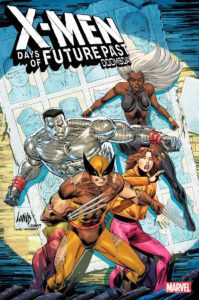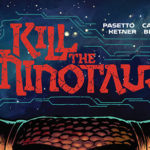
Everyone knows “Days of Future Past.” This iconic tale has inspired countless stories within both the Marvel Comics universe and comics in general.  Despite being only two issues, the storyline has been adapted for both film and television, and its impact on pop culture cannot be understated. In the original story, an older Kitty Pryde sends her consciousness back in time to her younger self, attempting to subvert a bleak future where mutants are hunted down and exterminated by the heartless machines known as Sentinels. The events that led up to the X-Men’s darkest timeline have been alluded to or seen briefly but have never been fully explored…until now!
Despite being only two issues, the storyline has been adapted for both film and television, and its impact on pop culture cannot be understated. In the original story, an older Kitty Pryde sends her consciousness back in time to her younger self, attempting to subvert a bleak future where mutants are hunted down and exterminated by the heartless machines known as Sentinels. The events that led up to the X-Men’s darkest timeline have been alluded to or seen briefly but have never been fully explored…until now!
X-Men Days of Future Past: Doomsday begins in the not too distant future, some time prior to the events of Uncanny X-Men #141. A handful of mutants, including Kate Pryde, husband Colossus, and their children are on the run from Sentinels. When tragedy strikes, Kate reflects on the events that brought them here, the clock ticking back over twenty years to reveal how things truly went wrong. Most fans will know about the assassination of Senator Kelly and the rise of the Sentinel program, but Kate’s narration reveals new details that paint a horrific portrait of the past, one that seems not so different from our own present day.
As bleak as the original storyline is, X-Men DOFP: Doomsday is even more dark and depressing. It’s a good read and feels important but definitely not what I would call fun. Writer Marc Guggenheim doesn’t hold back on the horrors of the future, depicting the graphic deaths of two long-standing X-Men in the issue’s brutal opening sequence, to say nothing of the horrible fates awaiting Kate’s family. Guggenheim addresses the lack of heroes in the future by showing, through Kate’s flashbacks, how anti-mutant sentiment is exacerbated over the years to the point where even non-mutant heroes are no longer safe, while a cabal of villains work behind the scenes to dismantle the superhero regime entirely. One hero retires as a show of solidarity to the mutants, while another falls victim to an angry mob in a scene of violence that is just heartbreaking
The plight of the X-Men has always served as a metaphor for oppressed sub-cultures and Guggenheim manages to use what could be considered an unnecessary prequel to say something about how the world is now. The true villains here are the so-called baseline humans, those who represent the notions of transphobia, homophobia, and racism, projecting their hatred and fear on a community that they see as less than human. To his credit, Guggenheim does a fine job of writing in a style that feels like a classic X-Men story, but the comparisons to real-world struggles makes it as contemporary as can be. Manuel Garcia’s art matches the writing with a classic approach that evokes Alan Davis during his prime, especially during scenes involving the team in their 80’s era uniforms.

![[REVIEW] SPIDER-GWEN ANNUAL #1](https://geekd-out.com/wp-content/uploads/2023/09/IMG_2559-150x150.jpeg)

